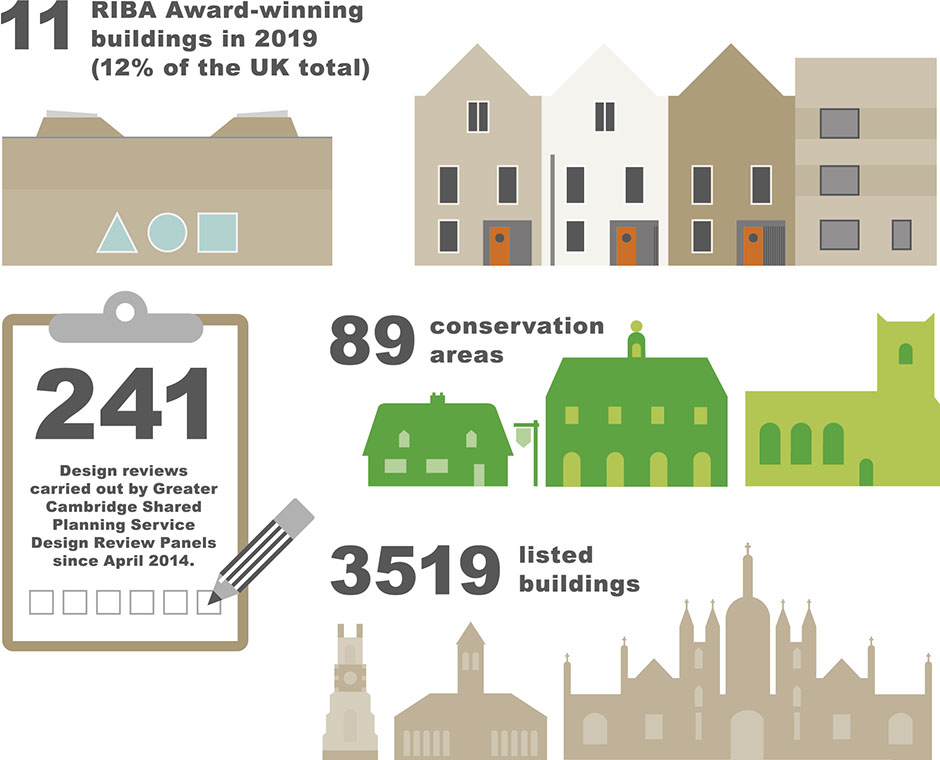Greater Cambridge Local Plan Issues & Options 2020
4.4 Great places
Figure 17 Greater Cambridge's heritage and design successes
Cambridge is an iconic historic centre of national significance. It is surrounded by a rural area with a unique landscape character, from the Greensand Ridge to the Fens. Greater Cambridge contains over 100 villages which are treasured for their architectural heritage and distinctive qualities, making them very desirable places to live and to visit.
There has been considerable growth in Greater Cambridge over recent years, and we have a track record as a place where contemporary design and the historic environment co-exist in harmony. The aim has always been to achieve high quality developments, and there have been many award-winning projects.
In planning for future new development, we need to consider how the next plan will protect and respond to the landscapes and townscapes that make our area special. We must not just protect the best places created by past generations – we should be creating outstanding new buildings and landscapes that will become the treasured heritage of future generations.
Question
(89) 21. How should the Local Plan protect our heritage and ensure new development is well-designed?
4.4.1 What do we have to do?
National planning policy states that good design is a key aspect of sustainable development, creating better places in which to live and work, and more support for development among communities. Plans should set out a clear design vision and expectations of developers, including place-specific design guidance and design codes where appropriate. The plan will also need to respond to the new National Design Guide[40].
Local Plans should contribute to and enhance the natural and local environment. This includes protecting and enhancing landscape and townscape, and the historic environment such as listed buildings and conservation areas.
4.4.2 What are we already doing?
The adopted 2018 Local Plans include policies seeking to secure good design through new developments, and these are supplemented by detailed design guidance, including joint guidance regarding sustainable design and construction, and an ongoing programme of conservation area appraisals.
The Cambridgeshire Quality Charter for Growth[41], developed by Cambridgeshire local authorities and partners, sets out key principles to improve the quality of new developments under the four broad themes of community, connectivity, climate and character. This has been reviewed by the Combined Authority in July 2019, with an additional fifth topic of cohesion, addressing measures to help create socially inclusive communities.
Cambridge City Council is also developing a Making Space for People supplementary planning document[42] for central Cambridge. This will be used to prioritise the delivery of improvements to key public spaces. South Cambridgeshire District Council is working with communities to develop individual Village Design Guides[43].
4.4.3 What are the key issues?
Protecting the best of what already exists
In planning for the future it will be important to protect what is best about the landscape and townscape of Greater Cambridge, including the many important historic buildings, conservation areas, and historic landscapes. We will need to consider:
- How to balance heritage protection with the demands of growth.
- How to ensure that our historic buildings have viable uses, so they can be maintained and safeguarded.
- How to balance public access to heritage with protecting sensitive sites from harm.
- How to sustain our historic landscapes while increasing biodiversity and adapting to climate change.
- How we can help historic buildings adapt to climate change whilst maintaining their heritage value.
- Ensuring local distinctiveness is maintained and enhanced.
Question
(85) 22. How do you think we should protect, enhance and adapt our historic buildings and landscapes?
Creating beautiful new buildings and places
We must not just protect the best places created by past generations – we should be creating outstanding new buildings and landscapes that will become the treasured heritage of future generations. 'Place-making' – creating and sustaining a positive and distinctive character in an area – is also important to our economic success, and this was identified by the Cambridge and Peterborough Independent Economic Review (CPIER)[44]. Some of the key issues we need to consider include:
- How successful our existing design policies have been in 'place-making' and ensuring quality.
- How to design and enhance public space.
- Continuing to benefit from the clear approach to design principles provided by the Cambridgeshire Quality Charter for Growth.
- How both the 'special' landmark buildings, and more everyday structures such as homes, shops, business units and infrastructure, can contribute to a positive sense of place and local identity through their design.
- How designing for climate change mitigation and climate change adaptation can be an opportunity to create distinctive and characterful developments.
Question
(118) 23. How do you think we could ensure that new development is as well-designed as possible?
[40] https://assets.publishing.service.gov.uk/government/uploads/system/uploads/attachment_data/file/835212/National_Design_Guide.pdf
[42] https://www.cambridge.gov.uk/consultations/making-space-for-people-vision-aims-and-objectives-and-strategies-consultation

